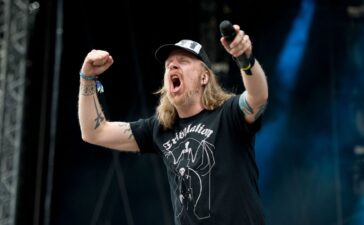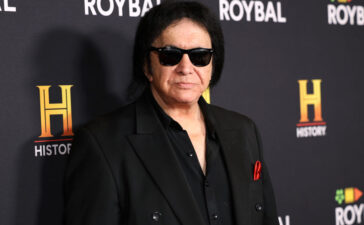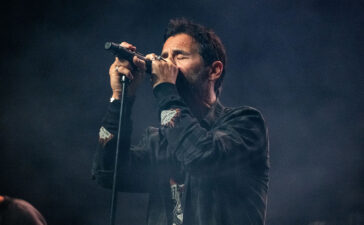Swedish melodic death metal progenitors At the Gates released their masterwork, Slaughter of the Soul, 25 years ago this month. Brendan Crabb delves into the record that helped define the much-heralded “Gothenburg sound”.
Origin story
The Gothenburg band formed in 1990 from the ashes of Grotesque, who had gained some traction, particularly amid the tape-trading scene. At the Gates had released an EP and three albums (The Red Sky is Ours, With Fear I Kiss the Burning Darkness and Terminal Spirit Disease) prior to Slaughter of the Soul.
“I remember being in this death metal fanzine very early in our career and it caused a little bit of a stir in the Swedish death metal underground,” frontman Tomas ‘Tompa’ Lindberg shared in 2012. “Adrian (Erlandsson, drums) got asked the question: ‘What is the main influence of At the Gates?’ And he said ‘love’. Which was kind of funny, because it was like, ‘You can’t say that, you’re a death metal band,’” he laughs. “But that’s it; that love and passion for what you do, that’s what he meant.”
Production
By 1995, At the Gates’ line-up comprised of Lindberg, guitarists Anders Björler and Martin Larsson, bassist Jonas Björler (Anders’ twin brother) and Erlandsson. Recorded at melodic death metal cornerstone Studio Fredman in Gothenburg, and overseen by co-producer Fredrik Nordström, Slaughter of the Soul was their first record for new label Earache Records. “Everybody was super concentrated on making this machine-sounding album,” Nordström remarks today of the vibe in the studio.
The LP took six weeks to record and mix in mid-1995. “I was in the middle of a divorce, which maybe instead of thinking of breaking up with my family, I was just into the album,” Nordström says. “I remember, Jonas, one of the brothers, he was pushing his brother so hard. He was sitting there complaining, more or less, at him for the whole guitar tracking. So when it was time to bass, he was exhausted. He didn’t have any energy left for doing bass. So the bass is kind of sloppily played on that album. That’s why you don’t hear the bass, except for one part. You never really think about it, but there is more or less no bass on that album. The bass is there, but it’s very low frequency. He is a good bass player, but I think he was just exhausted.”
Suicidal final art
Fun fact – the sound of a gun cocking that opens Suicide Nation was derived from Quentin Tarantino’s classic film Reservoir Dogs.
“A weird memory I have, I remember when we did the vocals with Tompa,” Nordström recalls. “That went super fast, he was just like so pumped up, and so he kind of nailed all the vocals in two days. I remember, Tompa had a girlfriend that was making his hair like dreadlocks, with small pearls in. And every time he would turn his head around, these pearls were flying all over the studio. So we had almost like these broken plastic pearls everywhere on the floor in the studio. Everybody really hated that,” he laughs.
Who devised the iconic catch-cry of “go!” during the intro of the title track? The co-producer pauses to consider before answering. “I think it was Tompa himself. It’s 25 years ago, 26 years ago I recorded that album – I don’t remember everything,” he chuckles.
The flames of the end
Released in November 1995, Slaughter… was well-received within the extreme metal world. Their most focused effort to date, it made its presence known in a taut less than 35 minutes. The album went on to be nominated for a Swedish Grammy, and the band performed in the US for the first time in support of it. The memorable video for Blinded by Fear was also one of Headbangers Ball‘s most-played clips. However, less than a year after the release, Anders announced he was quitting, and At the Gates abruptly ended. Several members soon found a new home with thrash metallers The Haunted, while Lindberg explored a variety of musical projects.
The gears of a reunion turned slowly, before At the Gates officially announced a series of gigs for 2008. Both interviews conducted at the time and also the 2010 The Flames of the End DVD indicated the reformation was almost certainly a short-term deal. However, the summer spark was reignited, as the group reconvened again in 2011 and discovered more territories they were yet to visit. The quintet continued to tour the world, including visiting Australia, enjoying the lucrative victory lap they never had the first time around.
“When we came back in 2008 it was not to prove a point or anything like this,” the vocalist told BLUNT in 2012. “It was more for ourselves, that we wanted to make this because it was important for us to have a real closure, you know?”
Under the influence
Despite the acclaim of the metal press at the time, the album’s influence and recognition as an era-defining masterpiece – thanks to a stunning fusion of irresistible hooks, Maiden-esque melodies and harmonies, and Slayer-style thrash aggression – wasn’t fully apparent until some time afterwards.
Aside from impacting on fellow Swedish acts such as Arch Enemy and Soilwork, many of the album’s tropes were appropriated by the ‘New Wave of American Heavy Metal’ several years later. The latter was a new generation of US metalcore and modern thrash acts, incorporating the likes of Killswitch Engage, All That Remains, Shadows Fall and God Forbid, not to mention a legion of long-forgotten and faceless pretenders.
Doc Coyle, guitarist for the now defunct God Forbid and currently of chart-topping rockers Bad Wolves, reflects on At the Gates’ importance to this burgeoning scene. “I discovered Slaughter of the Soul on a local college radio station, WSOU, around 1997,” he tells BLUNT today. “As a teenager burrowing deeper and deeper to find more extreme music, there was something about this that just stood out. This was a few years before bands like In Flames and Opeth would become household names in metal.
“It’s difficult to talk about this record without mentioning Carcass’ Heartwork, but Slaughter of the Soul just seemed to tap into a formula that was easier to define and therefore emulate. I say formula because the album is defined by its consistency across the record. With the exception of the two instrumental tunes, every song had certain specific elements. [These were] an unrelenting speed that was probably closer to thrash than death metal, a medieval and melancholy sense of melody that felt uniquely Scandinavian, compact pop-structured songwriting that did not suffer tangents or excess indulgence, Lindberg’s haunted scream that was singular but somehow emotive, and an undeniable, top-shelf production combined with tightly-played, technical performances by every instrumentalist. Nothing seemed off. No note was astray. It was a laser-focused vision that was executed to perfection and that only happens a few times a decade in extreme music.
“I think the other thing that was extremely appealing to American bands was that At the Gates were broken up. It made them seem more legendary, despite the fact that in their final days as a touring act the band did not have a lot of fanfare. To do a mic drop and exit stage left before people even knew you, on a perfect album, creates a mystique and bands start thinking, ‘Well, if they aren’t around to play this music, we might as well pick up the torch’. There were other melodic death metal bands before this album – Dark Tranquillity, Dissection, Amorphis – but the genre was distilled into its purest and most potent form by Slaughter of the Soul.”
Meanwhile, does Lindberg still detect elements of Slaughter… in a lot of bands? “I can see little bits and pieces here and there on records, but not the way we presented it. There’s a lot of different ideas on that record, like composition wise, so when they come together it sounds like that record, but one by one, it sounds like something else.
“Those (twin) guitars, Thin Lizzy has that, Wishbone Ash had that, Iron Maiden. Some bands have that, but when it all comes together in that special way, that’s when it’s us. But I never heard all those different ideas together in one band. But the period of writing it was really focused; we really wanted to make a statement that death metal was still a very important genre. When people started talking about the record and what we did, it’s more flattering than anything else of course. The bands that cited us an influence and all that, that was all good, you know? It’s flattering and it spreads the name as well, so it was all good.”
Nowadays one of metal’s most in-demand producers, Nordström says the LP served other key purposes. “I think it pushed many bands. I remember Jesper (Strömblad) from In Flames, he called me up, because we booked in a recording with In Flames. And he said, ‘I want to sound like that, I want to sound like that’. I said, ‘Yeah? Then maybe you should join the band, because In Flames doesn’t sound like that’,” he laughs. “For me, suddenly I would get phone calls from other countries, bands from England and Germany wanted to come to our studio and record. It really opened the door for people from other countries to come to Sweden to record.”
Still slaughtering
At the Gates’ members long maintained they wouldn’t release another studio album, but later relaxed their stance and issued 2014’s At War with Reality and 2018’s To Drink from the Night Itself, both well-received full-lengths that have only enhanced their legacy.
However, Slaughter of the Soul still looms over the Swedes’ catalogue like a phoenix, and the outfit was booked to play 25th anniversary shows this year. The majority of those plans were thwarted by the COVID-19 pandemic. “We were at the right place at the right time with Slaughter of the Soul,” the frontman says. “The death metal genre had kind of, it was a bit generic at that time and Slaughter… was something new and fresh. And it was also pretty accessible compared to our other stuff. You get like, this is what we got remembered for, but we had done a lot of stuff before that. You can never be really bitter about which part of your career that people focus on. You just have to be happy that people remember you at all.”







